Nec MULTISYNC LCD2060NX user Manual

MultiSync® LCD2060NXTM

Index
Warning .................................................................................................................... |
1 |
Contents ................................................................................................................. |
2 |
Quick Start ............................................................................................................. |
3 |
Controls .................................................................................................................. |
8 |
Recommended Use............................................................................................... |
11 |
Specifications ....................................................................................................... |
13 |
Features ................................................................................................................ |
14 |
Troubleshooting ................................................................................................... |
15 |
References ............................................................................................................. |
16 |
Limited Warranty ................................................................................................. |
17 |
TCO’99 ..................................................................................................................... |
18 |
Avertissement ...................................................................................................... |
21 |
Contenu................................................................................................................. |
22 |
Mise en marche rapide ...................................................................................... |
23 |
Commandes .......................................................................................................... |
28 |
Usage recommandé ............................................................................................. |
31 |
Fiche technique................................................................................................... |
33 |
Fonctions .............................................................................................................. |
34 |
Dépannage ............................................................................................................ |
35 |
Références ........................................................................................................... |
36 |
Garantie limitée .................................................................................................. |
37 |
TCO’99 .................................................................................................................... |
38 |

WARNING
TO PREVENT FIRE OR SHOCK HAZARDS, DO NOT EXPOSE THIS UNIT TO RAIN OR MOISTURE. ALSO, DO NOT USE THIS UNIT'S POLARIZED PLUG WITH AN EXTENSION CORD RECEPTACLE OR OTHER OUTLETS UNLESS THE PRONGS CAN BE FULLY INSERTED.
REFRAIN FROM OPENING THE CABINET AS THERE ARE HIGH VOLTAGE COMPONENTS INSIDE. REFER SERVICING TO QUALIFIED SERVICE PERSONNEL.
CAUTION
CAUTION: TO REDUCE THE RISK OF ELECTRIC SHOCK, MAKE SURE POWER CORD IS UNPLUGGED FROM WALL SOCKET. TO FULLY DISENGAGE THE POWER TO THE UNIT, PLEASE DISCONNECT THE POWER CORD FROM THE AC OUTLET.DO NOT REMOVE COVER (OR BACK). NO USER SERVICEABLE PARTS INSIDE. REFER SERVICING TO QUALIFIED SERVICE PERSONNEL.
This symbol warns user that uninsulated voltage within the unit may have sufficient magnitude to cause electric shock. Therefore, it is dangerous to make any kind of contact with any part inside this unit.
This symbol alerts the user that important literature concerning the operation and maintenance of this unit has been included. Therefore, it should be read carefully in order to avoid any problems.
Canadian Department of Communications Compliance Statement
DOC: This Class B digital apparatus meets all requirements of the Canadian Interference-Causing Equipment Regulations.
C-UL: Bears the C-UL Mark and is in compliance with Canadian Safety Regulations according to CAN/CSA C22.2 No. 60950.
FCC Information
1.Use the attached specified cables with the MultiSync LCD2060NXTM (L203FQ) color monitor so as not to interfere with radio and television reception.
(1)Please use the supplied power cord or equivalent to ensure FCC compliance.
(2)Please use the supplied shielded video signal cable.
Use of other cables and adapters may cause interference with radio and television reception.
2.This equipment has been tested and found to comply with the limits for a Class B digital device, pursuant to part 15 of the FCC Rules. These limits are designed to provide reasonable protection against harmful interference in a residential installation. This equipment generates, uses, and can radiate radio frequency energy, and, if not installed and used in accordance with the instructions, may cause harmful interference to radio communications. However, there is no guarantee that interference will not occur in a particular installation. If this equipment does cause harmful interference to radio or television reception, which can be determined by turning the equipment off and on, the user is encouraged to try to correct the interference by one or more of the following measures:
• Reorient or relocate the receiving antenna.
• Increase the separation between the equipment and receiver.
• Connect the equipment into an outlet on a circuit different from that to which the receiver is connected.
• Consult your dealer or an experienced radio/TV technician for help.
If necessary, the user should contact the dealer or an experienced radio/television technician for additional suggestions. The user may find the following booklet, prepared by the Federal Communications Commission, helpful: ”How to Identify and Resolve Radio-TV Interference Problems.“ This booklet is available from the U.S. Government Printing Office, Washington, D.C., 20402, Stock No. 004-000-00345-4.
1
LCD2060NXManual021104.p65 |
1 |
2/11/04, 7:40 AM |
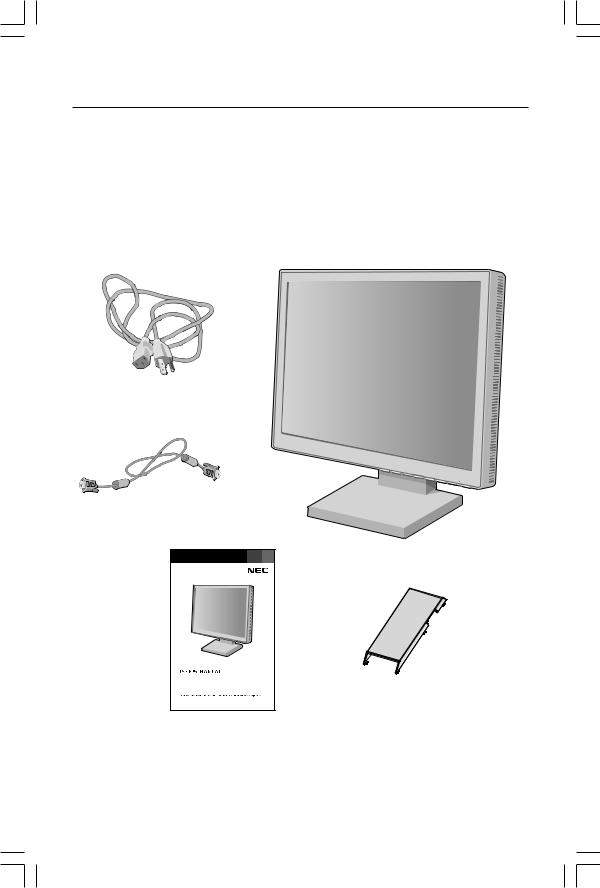
Contents
Your new NEC MultiSync® LCD monitor box* should contain the following:
•MultiSync LCD2060NX™ monitor with height adjustable base
•Power Cord
•Video Signal Cable
•User’s Manual
•Cable Management Cover
Power Cord
Video Signal Cable
MultiSync® LCD2060NXTM
Cable Management Cover
User’s Manual
* Remember to save your original box and packing material to transport or ship the monitor.
2
LCD2060NXManual021104.p65 |
2 |
2/11/04, 7:40 AM |
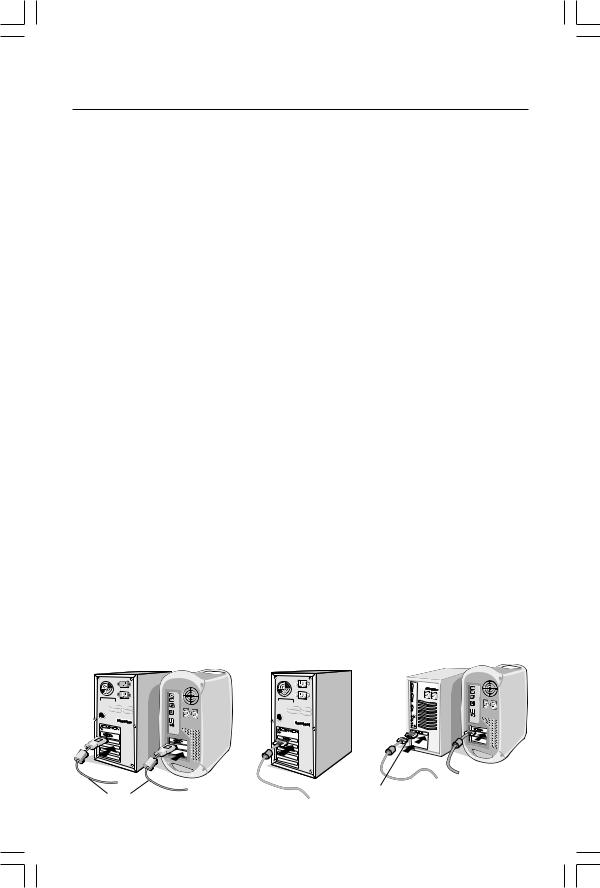
Quick Start
To attach the MultiSync® LCD monitor to your system, follow these instructions:
1.Turn off the power to your computer.
2.For the PC or MAC with DVI digital output: Connect the DVI signal cable (not included) to the connector of the display card in your system (Figure A.1). Tighten all screws. For the PC with Analog output: Connect the 15-pin mini D-SUB signal cable to the connector of the display card in your system (Figure A.2). Tighten all screws.
For the MAC: Connect the MultiSync Macintosh cable adapter to the computer, then attach the 15-pin mini D-SUB signal cable to the MultiSync Macintosh cable adapter (Figure B.1). Tighten all screws.
NOTE: To obtain the MultiSync LCD2060NXTM Macintosh cable adapter, call NECMitsubishi Electronics Display of America, Inc. at (800) 632-4662.
3.Remove the cable cover. Connect the 15-pin mini D-SUB of the video signal cable and DVI signal cable (not included) to the appropriate connector on the back of the monitor (Figure C.1).
4.Connect one end of the power cord to the monitor and the other end to the power outlet. Place the Video Signal Cable and power cord under Cable cover (Figure C.1). Replace cable cover.
NOTE: Adjust position of cable that place under cable cover, to avoid damage for cable or monitor.
NOTE: If you use this monitor at AC125-240V, please refer to Recommended Use section of this manual for proper selection of power cord.
5.The vacation switch on the right side of the monitor must be turned on (Figure D.1). Turn on the monitor with the front power button and the computer.
NOTE: The vacation switch is a true on/off switch. If this switch is on the OFF position, the monitor cannot be turned on using the front button. DO NOT switch on/off repeatedly.
6.Analog input only: No-Touch Auto Adjust automatically adjusts the monitor to optimal settings upon initial setup for most timings. For further adjustments, use the following OSM® controls:
•Auto Adjust Contrast
•Auto Adjust
Refer to the Controls section of this User ’s Manual for a full description of these OSM controls.
NOTE: For download information on the Windows® 95/98/Me/2000/XP INF file for your MultiSync LCD2060NX monitor, refer to the References section of this User’s Manual.
NOTE: If you have any problems, please refer to the Troubleshooting section of this User’s Manual.
Figure A.1 |
Figure A.2 |
Figure B.1 |
DVI signal cable |
|
Macintosh Cable |
Note: Some Macintosh |
|
|
systems do not require |
|||
|
Adapter (not include) |
|||
(not included) |
3 |
a Macintosh Cable Adapter |
||
|
||||
|
|
|
LCD2060NXManual021104.p65 |
3 |
2/11/04, 7:40 AM |

Quick Start –continued
Input1 (D-Sub) |
Input2 (DVI) |
Input1 (D-Sub) |
Input2 (DVI) |
|
|
|
|
|
|
|
|
|
|
|
Cable cover
Figure C.1
vacation switch
power button Figure D.1
4
LCD2060NXManual021104.p65 |
4 |
2/11/04, 7:40 AM |

Quick Start –continued
Raise and Lower Monitor Screen
The monitor may be raised or lowered in either Portrait or Landscape mode. To raise or lower screen, place hands on each side of the monitor and lift or lower to the desired height (Figure RL.1).
NOTE: Handle with care when raising or lowering the monitor screen.
Figure RL.1
Tilt
Grasp top and bottom sides of the monitor screen with your hands and adjust the tilt as desired (Figure TS.1).
Swivel
Grasp both sides of the monitor screen with your hands and adjust the swivel as desired (Figure TS.2).
NOTE: Handle with care when tilting the monitor screen.
5
LCD2060NXManual021104.p65 |
5 |
2/11/04, 7:40 AM |
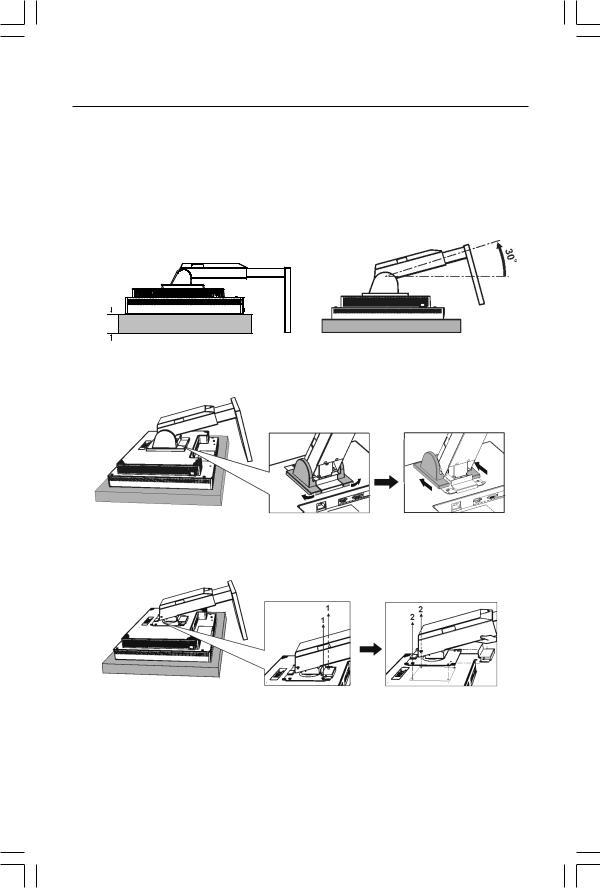
Quick Start –continued
Remove Monitor Stand for Mounting
To prepare the monitor for alternate mounting purposes:
1.Disconnect all cables.
2.Place hands on each side of the monitor and lift up to the highest position.
3.Place monitor face down on a non-abrasive surface. (Place the screen on a 51 mm/ 2.0 inch platform so that the stand is parallel with the surface.) (Figure S.1).
4.Adjust the stand into a 30 degree angle (Figure S.2).
51 mm
Figure S.1 |
Figure S.2 |
5.To remove two plastic covers: push the covers away from the stand then push toward the top of the monitor to release. (Figure S.3).
Figure S.3
6.Remove the 2 screws connecting the stand at the bottom (#1), then remove the 2 top screws (#2) to release the stand assembly (Figure S.4). The monitor is now ready for mounting in an alternate manner.
Figure S.4
7. Reverse this process to reattach stand.
NOTE: Use only VESA®-compatible alternative mounting method. (100 mm pitch) Handle with care when removing stand.
Caution: please use the attached screws (4 pcs) when mounting. To fulfil the safety requirements the monitor must be mounted to an arm which guaranties the necessary stability under consideration of the weight of the monitor. The LCD monitor shall only be used with an approved arm (e.g. GS mark).
6
LCD2060NXManual021104.p65 |
6 |
2/11/04, 7:40 AM |
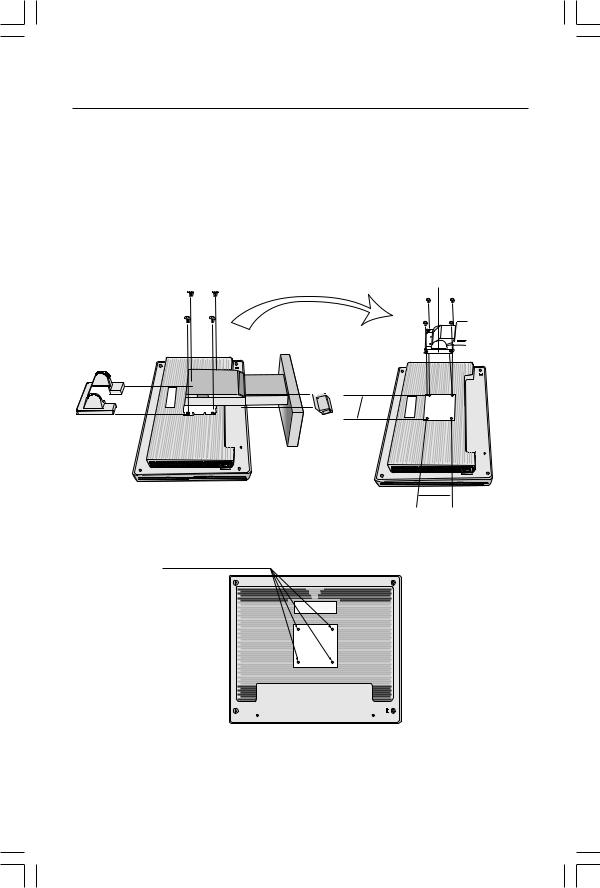
Quick Start –continued
This LCD monitor is designed for use with a flexible arm.
Please use the attached screws (4pcs) as shown in the picture when installing.
To meet the safety requirements, the monitor must be mounted to an arm which guaranties the necessary stability under consideration of the weight of the monitor.
The LCD monitor should only be used with an approved arm (e.g. GS mark).
|
Thickness of Bracket (Arm) |
Replace Screws |
2.0~3.2mm |
|
Tighten all screws. |
 100mm
100mm 
100mm
If using other screws, check depth of hole.
4 Screws (4M) (MAX depth: 8.0mm)
Weight of LCD assembly: 6.9 kg (MAX)
7
LCD2060NXManual021104.p65 |
7 |
2/11/04, 7:40 AM |
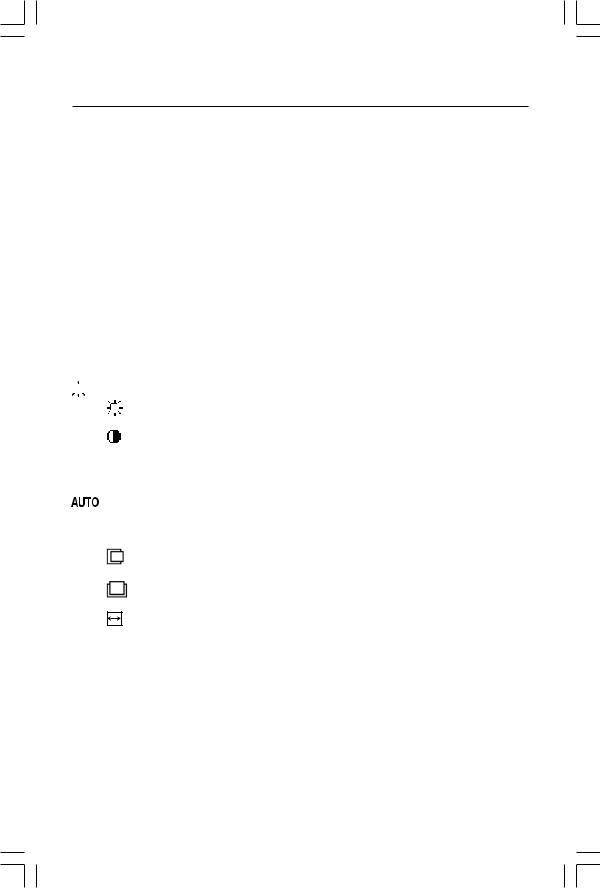
Controls
OSM® (On-Screen Manager) control buttons on the front of the monitor function as follows:
To access OSM menu, press any of the control buttons ( <, >, –, +, EXIT). To change signal input, press the SELECT button.
NOTE: OSM must be closed in order to change signal input.
|
Menu |
EXIT |
Exits the OSM controls. |
|
Exits to the OSM main menu. |
< / > |
Moves the highlighted area left/right to select control menus. |
|
Moves the highlighted area up/down to select one of the controls. |
–/+ |
Moves the bar left/right to increase or decrease the adjustment. |
SELECT |
Active Auto Adjust function. Enter the OSM controls. Enter the OSM sub menu. |
RESET |
Resets the highlighted control menu to the factory setting. |
|
|
NOTE: When RESET is pressed in the main and sub-menu, a warning window will appear allowing you to cancel the RESET function by pressing the EXIT button.


 Brightness/Contrast Controls
Brightness/Contrast Controls
BRIGHTNESS
Adjusts the overall image and background screen brightness.
CONTRAST
Adjusts the image brightness in relation to the background.
AUTO AUTO (Analog input only)
Adjusts the image displayed for non-standard video inputs.
Auto Adjust (Analog input only)
Automatically adjusts the Image Position and H. Size settings and Fine settings.
 Image Controls (Analog input only)
Image Controls (Analog input only)
LEFT / RIGHT
Controls Horizontal Image Position within the display area of the LCD.
DOWN / UP
Controls Vertical Image Position within the display area of the LCD.
H.SIZE
Adjusts the horizontal size by increasing or decreasing this setting.
 FINE
FINE
Improves focus, clarity and image stability by increasing or decreasing this setting.
 AccuColor® Control Systems
AccuColor® Control Systems
Six color presets select the desired color setting (sRGB and NATIVE color presets are standard and cannot be changed). R,G,B: Increases or decreases Red, Green or Blue color depending upon which is selected. The change in color will appear on screen and the direction (increase or decrease) will be shown by the bars. NATIVE: Original color presented by the LCD panel that is unadjustable. sRGB: sRGB mode dramatically improves the color fidelity in the desktop environment by a single standard RGB color space. With this color supported environment, the operator could easily and confidently communicate color without further color management overhead in the most common situations.
8
LCD2060NXManual021104.p65 |
8 |
2/11/04, 7:40 AM |
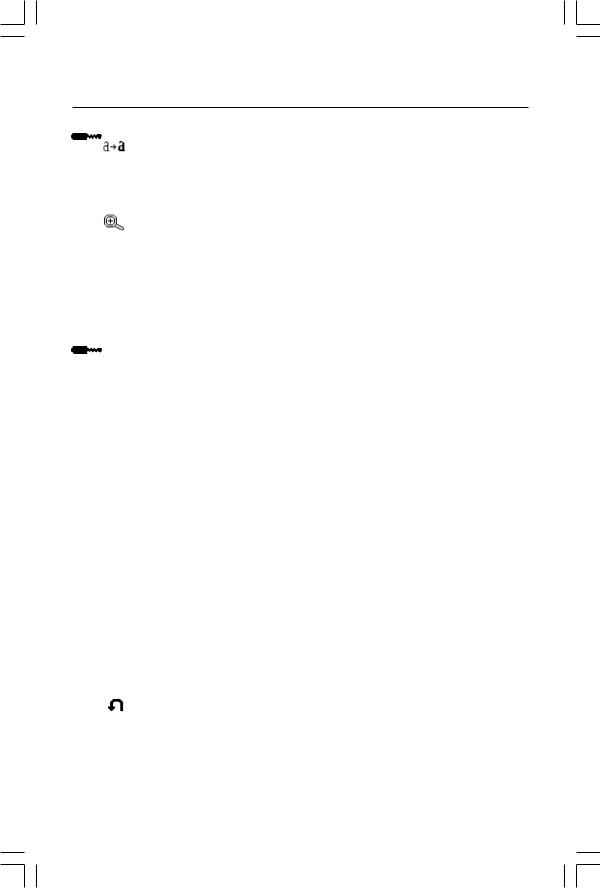
Controls
 Tools 1
Tools 1
SHARPNESS: This function is digitally capable to keep crisp image at any timings. It is continuously adjustable to get distinct image or soft one as you prefer, and set independently by different timings.
The number of adjustment steps is different depending on whether EXPANSION Mode is OFF, FULL or ASPECT (1600 x 1200 is OFF Mode).
EXPANSION MODE: Sets the zoom method.
FULL: The image is expanded to 1600 x 1200, regardless of the resolution. ASPECT: The image is expanded without changing the aspect ratio.
OFF: The image is not expanded.
 OFF TIMER: Monitor will automatically power-down when the end user has selected a pre-determined amount of time.
OFF TIMER: Monitor will automatically power-down when the end user has selected a pre-determined amount of time.
 Tools 2
Tools 2
 LANGUAGE: OSM control menus are available in seven languages.
LANGUAGE: OSM control menus are available in seven languages.
 OSM LEFT/RIGHT: You can choose where you would like the OSM control image to appear on your screen. Selecting OSM Location allows you to manually adjust the position of the OSM control menu left or right.
OSM LEFT/RIGHT: You can choose where you would like the OSM control image to appear on your screen. Selecting OSM Location allows you to manually adjust the position of the OSM control menu left or right.
 OSM DOWN/UP: You can choose where you would like the OSM control image to appear on your screen. Selecting OSM Location allows you to manually adjust the position of the OSM control menu down or up.
OSM DOWN/UP: You can choose where you would like the OSM control image to appear on your screen. Selecting OSM Location allows you to manually adjust the position of the OSM control menu down or up.
 OSM TURN OFF: The OSM control menu will stay on as long as it is in use. In the OSM Turn Off submenu, you can select how long the monitor waits after the last touch of a button to shut off the OSM control menu. The preset choices are 10-120 seconds by 5 second increments.
OSM TURN OFF: The OSM control menu will stay on as long as it is in use. In the OSM Turn Off submenu, you can select how long the monitor waits after the last touch of a button to shut off the OSM control menu. The preset choices are 10-120 seconds by 5 second increments.
 OSM LOCK OUT: This control completely locks out access to all OSM control functions without Brightness and Contrast. When attempting to activate OSM controls while in the Lock Out mode, a screen will appear indicating the OSM controls are locked out. To activate the OSM Lock Out function, press SELECT, then “+” key and hold down simultaneously. To de-activate the OSM Lock Out, press SELECT, then “+” key and hold down simultaneously.
OSM LOCK OUT: This control completely locks out access to all OSM control functions without Brightness and Contrast. When attempting to activate OSM controls while in the Lock Out mode, a screen will appear indicating the OSM controls are locked out. To activate the OSM Lock Out function, press SELECT, then “+” key and hold down simultaneously. To de-activate the OSM Lock Out, press SELECT, then “+” key and hold down simultaneously.
 RESOLUTION NOTIFIER: This optimal resolution is 1600 x 1200. If ON is selected, a message will appear on the screen after 30 seconds, notifying you that the resolution is not at 1600 x 1200.
RESOLUTION NOTIFIER: This optimal resolution is 1600 x 1200. If ON is selected, a message will appear on the screen after 30 seconds, notifying you that the resolution is not at 1600 x 1200.
 HOT KEY: You can adjust the brightness and contrast directly. When this function is set to ON, you can adjust the brightness with < or >, contrast with + or - key, while the OSM menu is off.
HOT KEY: You can adjust the brightness and contrast directly. When this function is set to ON, you can adjust the brightness with < or >, contrast with + or - key, while the OSM menu is off.
FACTORY PRESET: Selecting Factory Preset allows you to reset all OSM control settings back to the factory settings. The RESET button will need to be held down for several seconds to take effect. Individual settings can be reset by highlighting the control to be reset and pressing the RESET button.
9
LCD2060NXManual021104.p65 |
9 |
2/11/04, 7:40 AM |
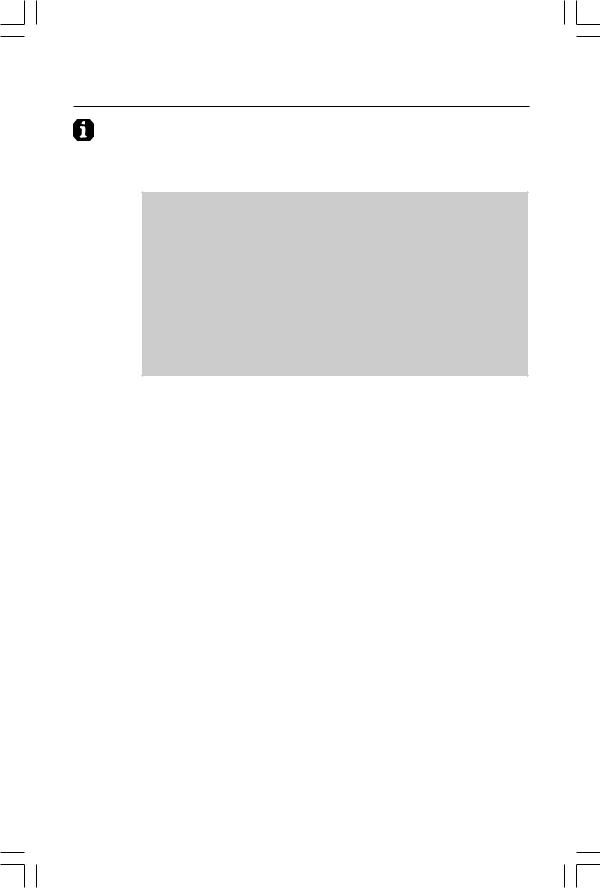
Controls –continued
Information
 DISPLAY MODE: Indicates the current display resolution and frequency setting of the monitor.
DISPLAY MODE: Indicates the current display resolution and frequency setting of the monitor.
 MONITOR INFO.: Indicates the model and serial numbers of your monitor.
MONITOR INFO.: Indicates the model and serial numbers of your monitor.
OSM® Warning: OSM Warning menus disappear with Exit button.
NO SIGNAL: This function gives a warning when there is no signal present. After power is turned on or when there is a change of input signal or video is inactive, the No Signal window will appear.
RESOLUTION NOTIFIER: This function gives a warning of use with optimized resolution. After power is turned on or when there is a change of input signal or the video signal doesn’t have proper resolution, the Resolution Notifier window will open. This function can be disabled in the TOOL menu.
OUT OF RANGE: This function gives a recommendation of the optimized resolution and refresh rate. After the power is turned on or there is a change of input signal or the video signal doesn’t have proper timing, the Out Of Range menu will appear.
10
LCD2060NXManual021104.p65 |
10 |
2/11/04, 7:40 AM |

Recommended Use
Safety Precautions and Maintenance
FOR OPTIMUM PERFORMANCE, PLEASE NOTE THE
FOLLOWING WHEN SETTING UP AND USING
THE MULTISYNC® LCD COLOR MONITOR:
•DO NOT OPEN THE MONITOR. There are no user serviceable parts inside and opening or removing covers may expose you to dangerous shock hazards or other risks. Refer all servicing to qualified service personnel.
•Do not spill any liquids into the cabinet or use your monitor near water.
•Do not insert objects of any kind into the cabinet slots, as they may touch dangerous voltage points, which can be harmful or fatal or may cause electric shock, fire or equipment failure.
•Do not place any heavy objects on the power cord. Damage to the cord may cause shock or fire.
•Do not place this product on a sloping or unstable cart, stand or table, as the monitor may fall, causing serious damage to the monitor.
•When operating the MultiSync LCD monitor with its AC 125-240V power supply, use a power supply cord that matches the power supply voltage of the AC power outlet being used. The power supply cord you use must have been approved by and comply with the safety standards of your country. (Type H05VV-F should be used in Europe)
•In UK, use a BS-approved power cord with molded plug having a black (5A) fuse installed for use with this monitor. If a power cord is not supplied with this monitor, please contact your supplier.
•Do not place any objects onto the monitor and do not use the monitor outdoors.
•The inside of the flourescent tube located within the LCD monitor contains mercury. Please follow the bylaws or rules of your municipality to dispose of the tube properly.
Immediately unplug your monitor from the wall outlet and refer servicing to qualified service personnel under the following conditions:
•When the power supply cord or plug is damaged.
•If liquid has been spilled, or objects have fallen into the monitor.
•If the monitor has been exposed to rain or water.
•If the monitor has been dropped or the cabinet damaged.
•If the monitor does not operate normally by following operating instructions.
•Do not bend power cord.
•Do not use monitor in high temperatured, humid, dusty, or oily areas.
•If glass is broken, handle with care.
•Do not cover vent on monitor.
•If monitor or glass is broken, do not come in contact with the liquid crystal and handle with care.
•Allow adequate ventilation around the monitor so that heat can properly dissipate. Do not block ventilated openings or place the monitor near a radiator or other heat sources. Do not put anything on top of monitor.
•The power cable connector is the primary means of detaching the system from the CAUTION power supply. The monitor should be installed close to a power outlet which is easily accessible.
•Handle with care when transporting. Save packaging for transporting.
Image Persistence
Image persistence is when a residual or “ghost” image of a previous image remains visible on the screen. Unlike CRT monitors, LCD monitors’ image persistence is not permanent, but constant images being displayed for a long period of time should be avoided.
To alleviate image persistence, turn off the monitor for as long as the previous image was displayed. For example, if an image was on the monitor for one hour and a residual image remains, the monitor should be turned off for one hour to erase the image.
NOTE: As with all personal display devices, NEC-Mitsubishi Electronics Display recommends using a moving screen saver at regular intervals whenever the screen is idle or turning off the monitor when not in use.
11
LCD2060NXManual021104.p65 |
11 |
2/11/04, 7:40 AM |

Recommended Use –continued
CORRECT PLACEMENT AND ADJUSTMENT OF THE MONITOR CAN REDUCE EYE, SHOULDER AND NECK FATIGUE. CHECK THE FOLLOWING WHEN YOU POSITION THE MONITOR:
•For optimum performance, allow 20 minutes for warm-up.
•Adjust the monitor height so that the top of the screen is at or slightly below eye level. Your eyes should look slightly
downward when viewing the middle of the screen.
•Position your monitor no closer than 16 inches and no further away than 28 inches from your eyes. The optimal distance is 20 inches.
•Rest your eyes periodically by focusing on an object at least 20 feet away. Blink often.
•Position the monitor at a 90° angle to windows and other light sources to minimize glare and reflections.
Adjust the monitor tilt so that ceiling lights do not reflect on your screen.
•If reflected light makes it hard for you to see your screen, use an anti-glare filter.
•Clean the LCD monitor surface with a lint-free, non-abrasive cloth. Avoid using any cleaning solution or glass cleaner!
•Adjust the monitor’s brightness and contrast controls to enhance readability.
•Use a document holder placed close to the screen.
•Position whatever you are looking at most of the time (the screen or reference material) directly in front of you to minimize turning your head while you are typing.
•Avoid displaying fixed patterns on the monitor for long periods of time to avoid image persistence (after-image effects).
•Get regular eye checkups.
Ergonomics
To realize the maximum ergonomics benefits, we recommend the following:
•Use the preset Size and Position controls with standard signals
•Use the preset Color Setting
•Use non-interlaced signals with a vertical refresh rate between 60-75Hz
•Do not use primary color blue on a dark background, as it is difficult to see and may produce eye fatigue to insufficient contrast.
For more detailed information on setting up a healthy work environment, write the American National Standard for Human Factors Engineering of Visual Display Terminal Workstations – ANSI-HFS Standard No. 100-1988 – The Human Factors Society, Inc. P.O. Box 1369, Santa Monica, California 90406.
12
LCD2060NXManual021104.p65 |
12 |
2/11/04, 7:40 AM |
